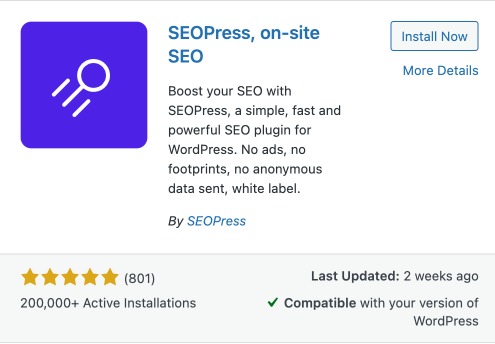TL;DR: Yoast SEO is now part of Newfold Digital. We predict the SEO plugin will be riddled with issues and our recommendation is to switch to SEOPress.
- What’s the problem with Newfold Digital?
- How does this affect Yoast SEO?
- Previous security woes with Yoast SEO
- Time to make a plugin switch
- How to switch from Yoast SEO to SEOPress
For many years, Yoast SEO has been the go-to plugin for optimizing your SEO for pages and blog posts. Its easy traffic light system and clear recommendations for what to change has helped many to boost their online visibility.
However, its place in the sun may be coming to an end due to an acquisition by Newfold Digital in August, 2021. It may be time to switch from Yoast SEO.

What’s the problem with Newfold Digital?
Acquisitions happen all the time and you may be wondering, why the big deal? After all, who really cares who owns Yoast? To understand the issues that may arise we need to look at who exactly Newfold Digital is and their background.
If Newfold Digital doesn’t sound familiar to you, that’s because it was only officially formed in 2021, when Clearlake acquired Endurance International Group (EIG). This last company, EIG, may be known to you as the group behind famous hosting providers such as HostGator, BlueHost, iPage, and FatCow (among many others).
If the fact that all these seemingly independent companies are owned by one umbrella group is a shock—that’s not an accident. The whole purpose of EIG was to grab as much share of the online hosting market as possible, which they will surely continue as Newfound Digital.
There is a common complaint when dealing with EIG. Firstly, as they overstuff their servers as a matter of routine, its services are generally quite unreliable and there are quite a few breakdowns. The worst example of this was in 2013/2014 when huge outages resulted in major problems for hundreds of businesses. And when things do go wrong, the customer service is famously bad, adding further insult to injury.
Many of EIG’s customers fall into an unsuspecting trap of getting upset with their specific provider (whether iPage or BlueHost, etc.) and then switching to another, only to find out that it’s owned by the same group. If you’re thinking about switching, the company’s Wikipedia page lists all its subsidiaries and is an easy way to find out who they own.
How does this affect Yoast SEO?
With Yoast specifically, the problem is likely to come from EIG’s practice of aggressive marketing tactics.
Our prediction is, the Yoast SEO plugin will continue to become more and more bloated. The added bloat will eventually cause website performance issues on the front-end and even more so on the backend (within wp-admin) with an increase in upsell marketing notices and advertisements. All of these changes will continue to degrade the usefulness and value of the free version of the plugin.
Previous security vulnerabilities
While the takeover is likely to make matters worse, Yoast has already had some worrying security issues over the last few years. A prime example of this was the version 9.1 vulnerability in 2018, which they also (unforgivably) failed to let users know about.
This wasn’t the only example, however. Using WPScan, we can see that they’ve had problems stretching back to 2014.
Time to make a plugin switch
Whether due to the acquisition or for security reasons, you may find the time comes where you want to switch from Yoast SEO. Thankfully, there are other great plugin options available on the market. For example, Rank Math is a great free plugin that serves as an alternative.
At Watchdog Studio, our preferred plugin is SEOPress.
SEOPress is very simple to set up and provides useful content analysis features, including:
- H2/H3 keyword check
- Meta keyword check
- Missing alt tags
- nofollow links
- noindex tags
Besides this, it has no security vulnerabilities to date and can be easily integrated into Google Analytics. Here’s how you install it.
Switch from Yoast SEO to SEOPress
Step 1. Keep Yoast active
It’s important not to deactivate Yoast SEO just yet. You’ll need to first copy the plugin’s data to SEOPress.

Step 2. Install SEOPress
Within the WordPress backend, go to Plugins > Add New and search for SEOPress. Install and activate the plugin.

Step 3. Migrate Yoast SEO settings
Navigate to the SEOPress > Tools settings page.
Find and click the Plugins section/tab.
Select Yoast SEO from the dropdown menu.
Click the “Migrate now” button under the WARNING about deleting SEOPress metadata.
Wait until it says “Migration Complete.”
Step 4. Deactivate Yoast SEO
Make sure to check that your meta descriptions and settings have been transferred correctly by reviewing a few posts and checking the SEOPress settings.
If everything looks good, you can now safely deactivate Yoast SEO from the Plugin dashboard.
Step 5. Make it official
If after a few weeks you’re happy with how SEOPress works, make the switch official! Simply delete the Yoast SEO plugin and you’re good to go.
Unsure how to maximize your SEO efforts? Our best-in-class SEO platform can guide you to create and execute a tailored SEO strategy that’s optimized for your business. Need more help and want to talk more about SEO, book a free consultation.


